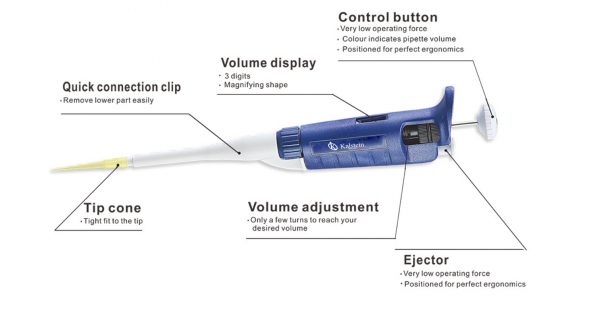Pipettes are precision devices ideal for liquid measurement needs in quality control and clinical testing laboratories. They are laboratory instruments used to absorb and transfer small volumes of liquids.
Nowadays, the use of micropipettes, the most modern version of these laboratory pipettes that allow the use of different liquids without having to wash the device, is worth noting: for this purpose, disposable plastic tips are used, which are usually sterile, since In turn, they work with microvolumes, bone very small volumes.
The volumes that can be captured by these instruments vary according to the model and type of pipette: the most common, called p20, p200 and p1000, admit a maximum of 20, 200 and 1000 μl, respectively.
How to properly pipette with a micropipette?
In order to reduce the margin of error in the laboratory, at Kalstein we recommend that you carry out the following steps for the correct use of pipettes, so as to reduce the margin of error when pipetting any substance or sample:
- Never turn the volume indicator dial beyond the upper or lower limit of the micropipette.
- The tips are one of the most important parts of the micropipette, it is necessary to ensure that they are the correct size and are always sterile.
- Pipetting is most accurate when the instrument is held at an angle of less than 20 ̊ from vertical.
- When releasing the liquid, it is recommended to support the tip of the micropipette lightly against the test tube, this way the surface tension helps to dispense the content.
- A common operator error is depressing the plunger to the second stop before filling the micropipette tip.
- It is important to verify that the tip fits with the minimum effort and that it comes out with the same ease; It is always advisable to review the micropipette manual so as not to make mistakes.
How often should I check and calibrate my pipettes?
As it is a volumetric material, pipettes must be kept properly calibrated, so this process must be carried out regularly. The main factors that will determine the calibration time are:
- Frequency of use.
- Recommendations from the manufacturer of the micropipette.
- Accuracy and precision required by the operation.
- Nature of the liquid to operate.
- Number of people operating the micropipette.
- Number of dispensers.
At Kalstein we are MANUFACTURERS of laboratory equipment of the highest quality, and designed with the best technology, and we have innovative automatic pipettes at the best PRICES on the market. That’s why we invite you to take a look at the Products menu. ICI

